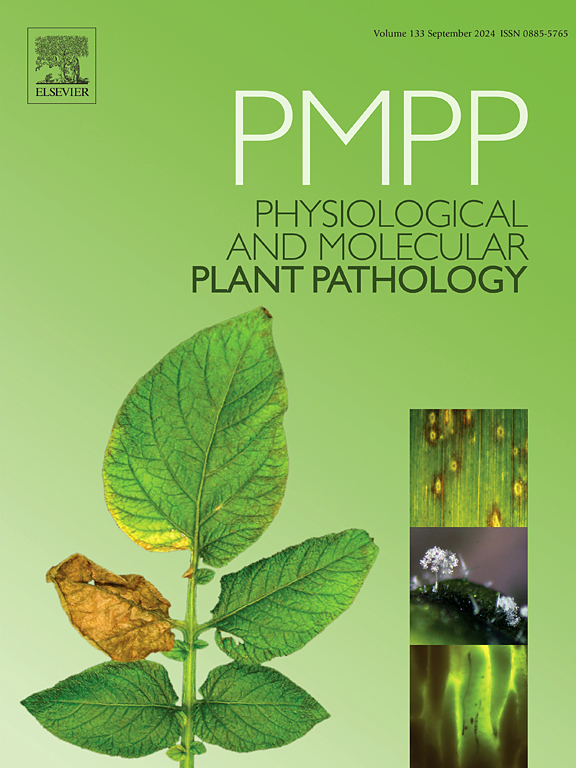Phenotyping and deciphering genetic resistance to yellow rust in wheat through marker-assisted analysis
IF 3.3
3区 农林科学
Q2 PLANT SCIENCES
引用次数: 0
Abstract
Wheat stripe rust, caused by Puccinia striiformis f. sp. tritici (Pst), is a major threat to wheat production throughout the globe including India. This study evaluated 110 wheat genotypes for resistance to stripe rust at both the adult plant and seedling stages over two consecutive years at two locations. Adult plant resistance was assessed based on disease severity, host response, and coefficient of infection. Among the tested germplasm, 3.63 % were immune, while 6.36 % exhibited slow rusting resistance. Moderately resistant and moderately susceptible responses were observed in 29.09 % and 21.81 % of the genotypes, respectively. Principal component analysis revealed that the first component accounted for 89.50 % of the total variability in infection coefficient data. Seedling resistance was evaluated against four Pst pathotypes (46S119, 110S84, 47S103, and 110S119), showing a wide range of infection types. Five wheat lines exhibited near-immunity, while several others showed strong resistance to multiple pathotypes, suggesting the presence of effective seedling resistance genes. Molecular characterization using 54 Yr-gene-linked markers identified a high frequency of Yr5, Yr35, Yr64, Yr46, and Yr7, while Yr32, Yr18, Yr65, and Yr36 were detected at lower frequencies. The presence of Yr10, Yr15, Yr18, Yr24, Yr29, Yr36, Yr44, Yr53, and Yr65 significantly contributed to resistance. In order to improve the resistance of wheat to yellow rust, breeding programs can make use of the carriers of useful Yr genes that were identified in this study.
利用标记辅助分析小麦抗黄锈病的表型和遗传抗性
小麦条锈病是由小麦条锈病引起的小麦条锈病,是包括印度在内的全球小麦生产的主要威胁。本研究连续两年在两个地点对110个小麦基因型在成株和苗期对条锈病的抗性进行了评价。根据病害严重程度、寄主反应和侵染系数来评估成虫的抗性。在被试种质中,3.63%具有免疫能力,6.36%具有缓蚀性。在29.09%和21.81%的基因型中分别观察到中度耐药和中度敏感反应。主成分分析表明,第一个分量占感染系数数据总变异性的89.50%。对4种Pst病原型(46S119、110S84、47S103和110S119)的幼苗抗性进行了评价,结果表明Pst侵染类型广泛。5个小麦品系表现出接近免疫,而其他几个品系对多种病型表现出很强的抗性,这表明存在有效的幼苗抗性基因。利用54个yr基因连锁标记进行分子鉴定,发现频率较高的是Yr5、Yr35、Yr64、Yr46和Yr7,而频率较低的是Yr32、Yr18、Yr65和Yr36。Yr10、Yr15、Yr18、Yr24、Yr29、Yr36、Yr44、Yr53和Yr65的存在对抗性有显著贡献。为了提高小麦对黄锈病的抗性,育种计划可以利用本研究中发现的有用Yr基因的载体。
本文章由计算机程序翻译,如有差异,请以英文原文为准。
求助全文
约1分钟内获得全文
求助全文
来源期刊
CiteScore
4.30
自引率
7.40%
发文量
130
审稿时长
38 days
期刊介绍:
Physiological and Molecular Plant Pathology provides an International forum for original research papers, reviews, and commentaries on all aspects of the molecular biology, biochemistry, physiology, histology and cytology, genetics and evolution of plant-microbe interactions.
Papers on all kinds of infective pathogen, including viruses, prokaryotes, fungi, and nematodes, as well as mutualistic organisms such as Rhizobium and mycorrhyzal fungi, are acceptable as long as they have a bearing on the interaction between pathogen and plant.

 求助内容:
求助内容: 应助结果提醒方式:
应助结果提醒方式:


